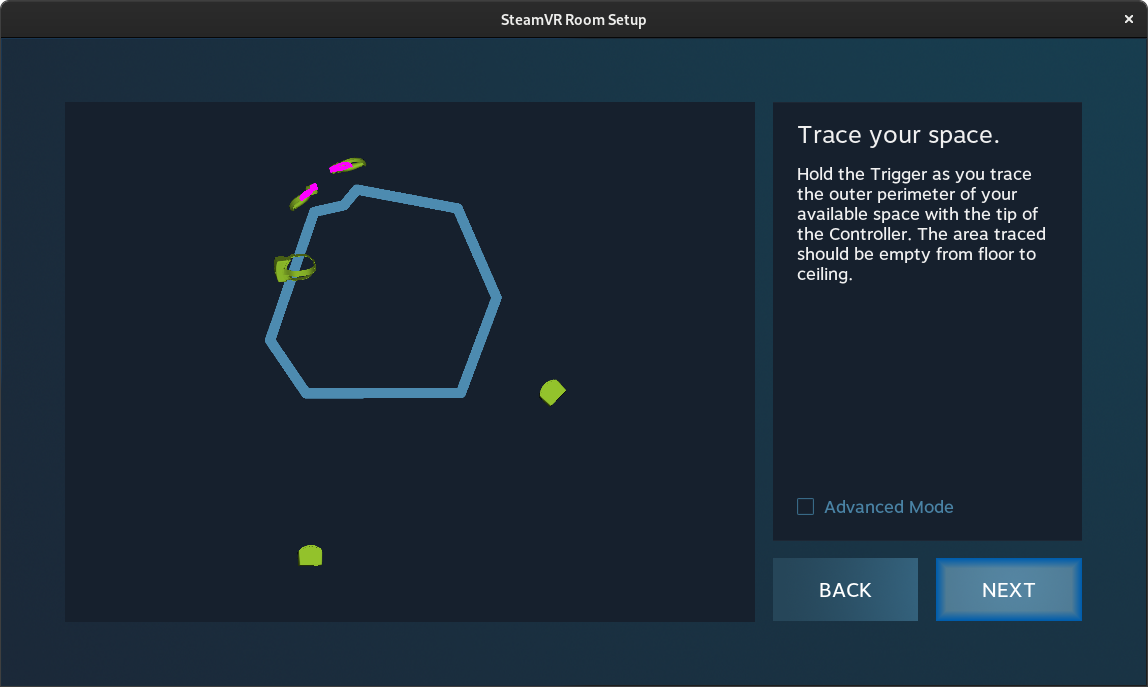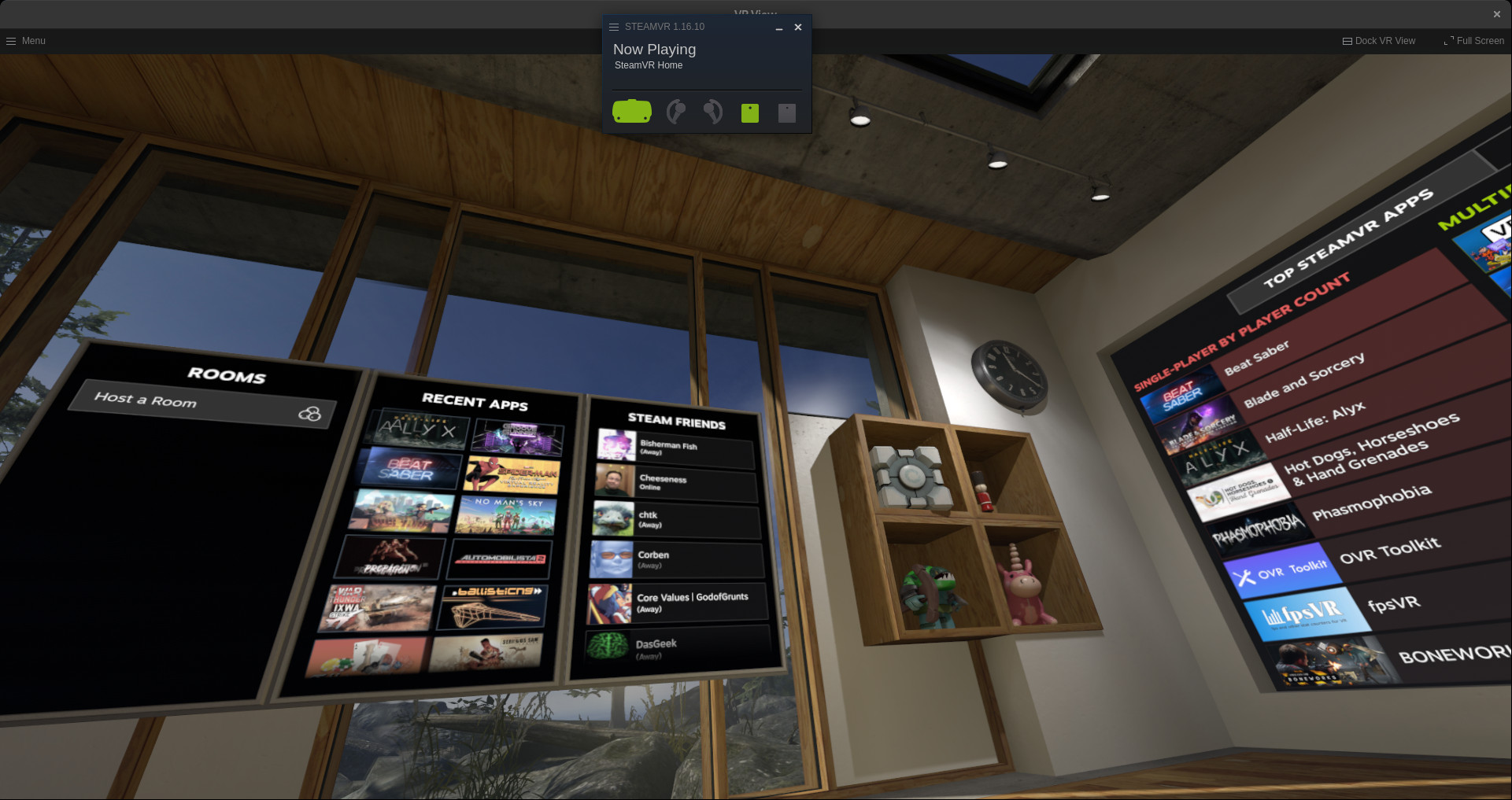-
chevron_right
VR is absolutely insane, I am officially a convert and it works mostly great on Linux
Liam Dawe · news.movim.eu / GamingOnLinux · Monday, 10 May, 2021 - 10:24 · 12 minutes
It is time! I finally have a Valve Index with thanks to supporter Scaine and it has genuinely blown a few braincells away with just how incredible an experience it actually is.
Unlike some, I wasn't originally sold on VR — at all . Partly because of the price factor, which is a genuine issue to adoption, especially with the more limited VR options on Linux with just the HTC Vive and the Valve Index. The big point was the idea of having a weighty device strapped to my face did not appeal to me. I stayed mostly away from it and didn't follow much - oh how wrong I have been all this time. It's simply like nothing else.

The Setup
I was expecting to come across lots of issues getting it all setup. Being much more than pleasantly surprised, it was click and play. Seriously, it can't get any easier than this. Read the instructions, plug everything in correctly and load the VR settings to calibrate things. After that, headset on and away you go. Okay, that's a slight lie. I did have one issue, which is audio not auto-switching to the headset but adjusting that quickly with PulseAudio Volume Control that makes it really easy to switch things around. Now that's all sorted and no problem.
Updating firmware for the Headset and both Controllers also worked perfectly. It tells you when an update is available, you click a button and it just does it. No fuss at all. Honestly, on an up to date Linux distribution - the SteamVR setup is ridiculously easy. You don't even have to opt into any Beta, or resort to anything on the command line, everything is nicely in the Steam UI.
System Specifications
- Distribution: EndeavourOS (Arch Linux)
- Kernel : 5.11.16
- Desktop Environment: GNOME
- RAM: 16GB
- CPU Model: Intel i7 5960x
- GPU Model: NVIDIA 1080 (v465.24.02 driver)
Technically, according to Valve's GitHub SteamVR is still a development release for Linux. So even though they don't seem to consider it properly stable for Linux yet, the situation is still technically extremely impressive. Whoever has been working on the Linux side of SteamVR at Valve - keep it up, you're doing awesome. VR overall is still pretty much in its infancy really and to have Valve support it like this on Linux is again amazing - when you think about the small user share of the operating system for the desktop.
I only have quite a small space to do my VR in too, and even here it works very well. Initially trying out the room scale, where you need to map out your area by walking around while holding down a controller trigger, it only just gave me the okay with a few gentle area tweaks. You don't actually need a space that big which was something of a surprise. That said, I nearly punched out a window and walked into a wall and a door - so standing-only it is with not too much movement. Even so, the standing option still has quite a bit of leeway on foot movement.
Don't have much more to say on the setup, because there's really not much to it. Plug it in, install SteamVR and some games and that's pretty much it overall. No fancy steps needed, because Steam handles everything rather gracefully for you it's just so damn impressive.
Notes for streamers and video content creators
If you're going to capture footage with OBS Studio , ensure you have unchecked the option to capture your mouse cursor. I found that out the hard way with ruined footage due to a nice big cursor in the middle of it. See also: our first VR livestream VOD .
Additionally, it's better to capture the VR View, rather than the game window as you can set it to capture both eyes to give viewers a much wider angle and it just looks better. For both eyes it does give a slight transparency bar towards the centre where it merges the two but it's still fine.
To access it, open the menu from the SteamVR Status box and hit Display VR View. This window seems to have some weird non-standard behaviour and doesn't correctly fill the screen for capturing, so you can force it to adjust with a simple command like this (thanks Corben!):
WIN=$(wmctrl -lG | grep VR\ View | awk '{ print $1 }'); wmctrl -i -r $WIN -e 2,0,0,1920,1110
The Feels
As someone who doesn't have the best vision and has to wear glasses, that was something I was concerned about. As it turns out, not an issue. You really can wear glasses quite comfortably with the Index headset squeezed on tight. Valve clearly though about many types of people and faces when designing it which is quite a big relief. Thankfully it means playing for longer periods is possible without major eye-strain. Although, you can also get special lens cover inserts through VR Optician to match the strength of your glasses which is certainly interesting.
You're absolutely going to want some lens protection though! The Valve Index can be easily scratched, so get some covers on it. I went with the Valve Index Lens Protector from Prettygood3d on etsy, along with a simple silicone cover for the Face Gasket so it can be kept clean and fresh a little easier.
Something else that's been really freeing for me are the controllers. I have a permanent injury in my right wrist, which is painful often and using a mouse or a gamepad can really aggravate it. The Index controllers though? No problem, there's no pain at all. It's strapped to you and moves with you, it's been so freeing.
Game Selection
Right now, the selection of games is limited — for Linux especially. Currently there's around 2% of people on Steam that have a VR set hooked up ( Steam Hardware Survey ), so we're clearly talking about a niche within a niche here so it's not exactly surprising. Thankfully, Proton exists which saves the day here pretty much. Without it, there wouldn't be much VR at all on Linux and considering how it's a small market inside the clear niche, it's going to stay that way for a while to come.
Games tested and working well so far include:
- Half-Life: Alyx - native
- Groove Gunner - native
- Beat Saber - Proton
- Pavlov VR - Proton, although that I refunded because frankly it felt poor. Guns vanishing all the time made it a nuisance to play and so just wasn't fun. Seems to be by design too, quite a lot of complaints about it around.
- Spider-Man: Far From Home Virtual Reality - wonderful for kids.
Initial Gaming Thoughts
Where to even begin on how it feels to play? I now understand why people suddenly started asking for VR versions of games. I have joined the ranks of people wanting more full VR experiences. VR is something you truly cannot appreciate unless you have actually tried it for a few hours - there's no really good way to describe it, it just transforms everything .
Movement is the worst part to get used to as a newer user. Thankfully, when you buy the Valve Index they kindly throw in a copy of Half-Life: Alyx, which has different movement modes built in. For new VR users, starting with the Blink movement mode is a must, allowing you to quickly teleport to a location. The first time I tried the traditional stick-based push to walk movement mode, I nearly puked everywhere, it was really quite horrible to see everything moving like that so close to my face without me actually doing the walking. Like most things though, you do eventually get used to it and quicker than expected but it still makes me feel a little dizzy when used too much. So, Blink is the best to avoid sickness.
It's such a convincing experience in fact, that I often get vertigo when looking down from a height in VR. The experience is certainly an impressive one. Overwhelmingly impressive when you first start that is. I've bumped into many things, nearly punched through a window and more, it's an experience that simply cannot be compared with when it comes to gaming - but you do need the right games for it.
Half-Life: Alyx, for example, is the gold standard on a full VR story experience. Not surprising though, if it was anything less people would be seriously questioning why they got the Valve Index. The graphics are simply fantastic and the gameplay is brilliant. It's very much a Half-Life game down to the core too, everything about it reminds me of Half-Life 2 but turned up to 11. At times it's so tense you might pop, other times it's just wondrous to walk around a bit and interact with various parts of the environment. An absolutely extraordinary game, and it's pretty darn scary too. There's been numerous times I've completely forgotten how to reload in a total mad panic.
Enjoy a few minutes of me failing in the below video:

Watch video on YouTube.com
The tenseness of gaming in VR can be quite a strain too. Stretching first is a must, as is trying to remember not to stiffen up. Playing faster paced-games like Groove Gunner, Beat Saber and the likes can easily make you sort-of lock up. Keep moving a little otherwise, you're going to ache. Bending your knees a little is a must. I forgot once or twice and felt the pain after a session.
What I am most surprised by is the performance. With my NVIDIA 1080 (as our 2080 is in a different machine), it's been very smooth with the titles I've put some time into. I was fully expecting to need to pull out the 2080 for this but so far it hasn't been needed.
Technical Issues
There are some technical issues to be aware of though. The situation is far from perfect. For starters, sometimes SteamVR as a whole just dies on you. You might be trying to load a game, and find yourself stuck in the loading area limbo and - nothing happens. On top of that, the in-game SteamVR overlay often just doesn't work so you have to restart SteamVR until it does. Thankfully, restarting SteamVR is a pretty quick experience so it's not too much trouble but definitely still very very annoying.
Out of the box the microphone will also not work, this is an issue with Pulse Audio it seems. Opening this file:
/etc/pulse/daemon.conf
And setting this:
default-sample-rate = 48000
Will fix it and then you have the working microphone. However, some times it seems to just fail to initialize. Restarting SteamVR and the headset seems to fix that. Doesn't happen often but it does happen.
Like taking screenshots? Well, here's another problem, you can't take them with the controllers. F12 on the keyboard works but it seems still years later it's not working as it should be and that's not helpful when you have a headset on. Want to adjust your volume in the SteamVR Overlay? That doesn't work either, also hasn't for years .
Games played through Proton often seem to have audio crackling too. I'm not entirely sure yet on a good solution to properly solve it. Setting the commonly given "PULSE_LATENCY_MSEC=60 %command%" launch option does nothing, restarting Pulse Audio also does nothing. The only way I've found is having Pulse Audio Volume Control open. It would be good if the root cause of this issue could be found, as it's the single most annoying thing about SteamVR on Linux right now.
If you're a Twitch or YouTube livestreamer, getting the chat to show up in your HMD is not exactly click and play. Sadly, there's currently no really simple way to do it. I'm currently waiting on Collabora upgrading xrdesktop for GNOME 40, so I can bring over a transparent chat window overlay. Once that's working, I'll be testing and reporting on that.
Lastly, not a technical issue but something to know - the Base Stations give off quite an annoying high-pitched noise when turned on. Thankfully though it is quite quiet but I imagine for some it could give headaches but you don't hear it when you have even some quiet music on so it's not too bad. The Base Stations on Linux won't power down when you're done. Not a big problem but the sound is annoying, you can try something like the SteamVR Utils for Linux or just have them in a switchable power-socket which is faster than any powering up/down via software.
So, there's plenty of rough edges you need to be aware of when doing SteamVR on Linux. I've covered a few on the main annoying bits here.
More thoughts
Is VR like this the future of gaming? Originally, I would have laughed at anyone who said yes. Now though? I'm not so sure. It's so ridiculously immersive that you forget you're even wearing a headset. To the point that I've punched the headset a few times when bringing my hands up — woops. Still, a high price and wiring everywhere are two issues I hope are eventually solved to make it the future. More headsets are coming out at lower prices which is good and wireless is coming along so eventually they might be a much smaller issue.
Also, once you've got your full kit, that's not the end of your expenses. Oh no. You're going to want replacement face covers, or a cover to put over your existing one to protect it further. The previously mentioned lens covers to protect them too, the high of buying up all the VR games you can get your hands on to experience more of it, controller covers, perhaps even a pully system to hold up the wire from the floor and the list goes on. Prepare to splash out and get seriously broke.
Playing in VR definitely makes going back to flat/pancake (or whatever you want to call it) gaming feel…weird. Everything else now feels so far away and moving a mouse to turn a camera? What is this, the stone ages? I need more VR, MORE! That said, I can't imagine how sweaty and gross an experience it's going to be in the hotter months of the year, and in the UK we don't really have houses with air conditioning but we don't have plenty of insulation so we're not exactly ever prepared for warmer times.
While my time with it is limited so far (SteamVR says ~33 hours clocked), it's already safe to say that VR on Linux with the Valve Index seems pretty fantastic. I do hope many more people get to experience it. It's a complete brain and senses overload, it's amazing .











